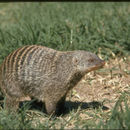en
names in breadcrumbs


Mungos is a mongoose genus that was proposed by Étienne Geoffroy Saint-Hilaire and Frédéric Cuvier in 1795.[1]
The genus contains the following species:[2]
Mungos is a mongoose genus that was proposed by Étienne Geoffroy Saint-Hilaire and Frédéric Cuvier in 1795.
The genus contains the following species: